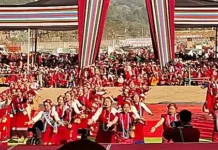[Dani Sulu]
Social media is abuzz with opinions on the district quota and heated discussions are going on about it’s advantages and disadvantages, it’s constitutionality and unconstitutionality.
As is wont, where the young mind is stirred up and emotions take over from rationality, most of the arguments are based on the assumption of the ‘what’ and the ‘how’ of the district quota, rather than on how it exists in government orders and notifications, and also how it exists and is practiced in reality by the departments and the district administrations.
The heated debate was triggered by the meeting held 16.10.2019 between representatives of the state government and the All Nyishi Youth Association, which was demanding, besides other things, implementation of the district quota by the Arunachal Pradesh Staff Selection Board (APSSB) while carrying out recruitment, and the letter issued thereof, on 16.0.2019 itself, by the state government, conveying to the various government departments and the APSSB the existence of the district reservation in Group C and Group D posts, and how the APSSB should recruit by inviting applications from the bonafide candidates of the district concerned for the posts that are reserved for that particular district. The much-debated letter, dated 16.10.2019, is neither a government order nor a government notification. The letter only conveys the existence of previous government orders on district reservation, and it doesn’t provide for district quota, but only conveys the rule in existence to the departments and the APSSB.
The APSSB is only a recruiting body and will recruit as per the requisitions placed by the departments, and also as per the rules and regulations framed by the government of Arunachal Pradesh from time to time.
Now the question is whether the district reservation exists, and, if so, since when it is existing, for which posts it exists, and whether it has been practiced on the ground.
The government order for recruiting Group C and Group D posts in the district establishments and also in all the departments, except engineering and forest departments and certain identified posts of other department, can be traced to the government order of 1981. The excerpt of the government of Arunachal Pradesh order, issued vide No GA-56/78, dated Itanagar, 10 September, 1981, are as follows.
Shape and extent:
All ministerial (Group C) posts now borne on the district establishments of different major and minor departments, including the deputy commissioner’s establishment (but excluding the engineering and forest departments) in the districts shall constitute one single common cadre for each district, for which the deputy commissioner of the district shall be the cadre authority, subject to such exceptions as the government may, by any general or specific order, make from time to time.
Title:
This newly-formed ministerial (Group C) cadre for each district shall be known as the district ministerial (general) cadre of Tirap district or Lohit district or Dibang Valley district and so on, as the case may be.
Appointing and cadre authority:
The deputy commissioner of the district concerned shall be the only cadre controlling and appointing authority in respect of all posts borne in this cadre. Henceforth, no head of department (both major and minor) or district heads of offices, other than the deputy commissioner, shall make any appointments, including short-term, officiating and adhoc appointments. (However, the offices of the assistant director of health services (T&R), Pasighat, the assistant director of health services (MSD), Arunachal Pradesh, Rowriah, the principals of JN College and Gramsevak Training Centre, Pasighat, principals, Government Degree College, New Itanagar BSB, Changlang, Industrial Training Institute, Roing, superintendents, TB hospital, Margherita, general hospital Itanagar, zonal leprosy officer, Itanagar and surplus assistant of DST’s establishment originally deployed in the districts and subsequently absorbed in the establishment of the director of civil supply set up will not come under the preview of this order. (The same provision for Group D posts are also contained in this order with slight difference, considering the difference in the nature of jobs between these two groups.)
Addition of posts to the cadre:
Subject to the constitution of the cadre as indicated above, and also subject to such exceptions as the government may, by general or special order, make from time to time, all Group C (ministerial posts created or deemed to have been created for different offices of all major and minor departments, including the establishment of the deputy commissioner in the districts of Arunachal Pradesh, but excluding the engineering and forest departments, on or before the date of issue of this order, shall be specific additions to this newly-formed cadre under the deputy commissioner of each district.
It shall be obligatory on the part of the head of department concerned to endorse copies of the sanction orders for creation of new ministerial posts (both under plan and non-plan) to the concerned DC for filling up such posts by the DC.
The government order of 1981, though it categorically directed that the appointment of Group C and Group D will be made by the DCs and not by the HoD (except engineering, forest and certain field offices of department as brought out in the order), it did not clearly lay down whether the recruitment will be made from among the bonafide residents of the particular district only.
However, the government order of 1997 clearly laid down how many of the Group C and D posts will be recruited to from the bonafide residents of the particular district only. The government notification, No OM-38/76, Vol-II, dated 27/08/1997, states: ‘In the exercise of power conferred by the clause (4) of the Article 16 and in terms of Article 335 of the constitution of India, the governor of Arunachal Pradesh is pleased to order 80 percent of Group C and D posts reserved for the Arunachal Pradesh Schedule tribe candidates are filled up by direct recruitment at the district level as per provision of various recruitment rules in force shall be distributed amongst the districts of Arunachal Pradesh in the following manners:
Eighty percent posts out of 80 percent reserved for common APST candidates shall be reserved for the APST candidates of the district concerned, including candidates from the interior places of that district.
The remaining 20 percent posts out of the 80 percent posts as stated above shall be reserved for APST candidates from others districts of the state.
Appointment to Group C and D posts against the district shall be made at the district level as per ratio as indicated at (i) and (ii) above.’
A slight amendment was carried out vide notification No OM-38/76, Vol-II, dated 31/03/1998, which states: ‘In pursuance of government notification, vide notification No OM-38/76, Vol-II, dated 27/08/1997, it has been decided by the government that while filling up the 80 percent (out of 80 percent) of the Group C and D reserved posts by direct recruitment at the district level as per the procedures outlined therein, preference (other things being equal) should be given to the candidates belonging to the backwards area or tribes inadequately represented in the public employments.’
This amendment was carried out to ensure that people from backward areas or the tribe from that particular district is adequately represented.
Further amendment was carried out during 2011 by the government of Arunachal Pradesh, vide its notification No AR-47/10, dated 02/06/2011, which says: ‘In the exercise of power conferred by the clause (4) of the article 16 and in terms of 335 of the constitution of India, the governor of Arunachal Pradesh is pleased to modify the government notification No OM-38/76, Vol-II, dated 27/08/1997, and order that the 80 percent of Group C and MTS (erstwhile Group D) against the direct recruitment quota reserved for the APST candidates borne under all departments at the district level as per provisions of the various recruitment rules in force on the following manners:
‘100 percent posts out of 80 percent as stated above in Group C and MTS posts borne in all departments at the district offices including district administration shall be filled up from amongst the APST candidates of the districts concerned.
The recruitment to these posts, including future vacancies, shall be conducted at the district level by a selection board/ committee under the chairmanship of the deputy commissioner of the district to be constituted by the department concerned. A seniority level not below the rank of the deputy director of the respective directorate/HoD shall be one of the members of the selection board/committee in conformity with the provisions of the recruitment rules to the respective posts.’
This same order has been conveyed in the letter dated 16.10. 2019 to all the departments, DCs and the All Nyishi Students’ Union, with a direction to the APSSB to invite applications from the bonafide candidates of the district concerned only for the posts that are reserved for that particular district.
The recruitment to the Group C and D posts has been followed by the district administration and departments by following the above government orders. The Group C and D posts of all the departments and district administrations are done by the deputy commissioners. The exceptions are the engineering departments, forest department, the offices of the assistant director of health services (T&R), Pasighat, assistant director of health services (MSD), Arunachal Pradesh, Rowriah, principals of JN College and Gramsevak Training Centre, Pasighat, principals, government degree college, New Itanagar BSB, Changlang, Industrial Training Institute, Roing, superintendents TB hospital, Margherita, general hospital Itanagar, zonal leprosy officer, Itanagar etc, as brought out in the government order of 1981.
However, the recruitment process as practiced is not without any shortcomings or trespasses. On many occasions, the posts which are meant for district recruitment are recruited to by the department and posted to that district. And on many other occasions, posts which are to be recruited by the departments are recruited at the district level. Most of these transgressions happen because of ignorance about which posts of departments are district cadre posts and which are department cadre posts. There are also complaints about practice of nepotism and also of political pressure in the recruitment process of Group C and D, both at the district level as well as directorate level.
The present government has established the APSSB to facilitate merit-based, transparent, and accountable recruitment process. The APSSB will recruit for both the district establishment and the departments as per the requisition put by them as per the existing rules in force. The APSSB has neither increased nor decreased the district reservation of Group C and D which have existed since 1981. It is only an autonomous recruitment body. The youth of today have the privilege of getting government jobs through a competitive exam, based on merit. The arguments over the district quota should give way to discussions on how to ensure posts meant for department cadre are not confused for district cadre, and posts meant for district cadre are not confused for department by the authorities concerned. The discussions and attention should also focus on how the APSSB can be strengthened, made more transparent, reliable and accountable for merit-based recruitment. (The writer is Secretary, GoAP. The opinion expressed is his own and not necessarily of this daily. The writer asserts that it also ‘does not reflect’ the government position he holds.)




